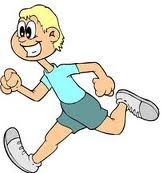Let
the Games Begin
Thanks
L. Fielitz, E.
Merrigan, C. Yunker, D. Van Dam, J. Freeman, J. Suby, J. McVan

.
Warm-up games
provide a varied and
enjoyable method to increase the heart rate and body temperature of the
participants with the use of agility, movement and coordinating
activities in preparation for the class or practice activity.
This article provides several examples of warm-up games that will add
variety to the class or practice while participants enjoy a mixture of
movement patterns that assist them in preparing for the next physical
activity.
Warming up the body by increasing the heart rate, raising the body
temperature and getting ready for a higher level of physical activity,
is recommended by various groups ranging from the American College of
Sports Medicine (2012) to the Mayo Clinic (2011).
Physical education teachers and coaches usually have their students and
athletes perform some type of warm-up activity and stretching prior to
class or practice.
Some teachers and coaches have the students or athletes take a few laps
and then go through a series of stretches in preparation for the
subsequent activity.
The goal of the warm-up is to prevent injuries through low intensity,
large muscle activity.
The warm-up provides increased blood flow and oxygen to the muscles,
primes the nerve-to-muscle pathway and improves coordination and
reaction times (Spark People, 2013).
Prior to rigorous physical activity, low-intensity, submaximal aerobic
activity should be conducted followed by some type of stretching and
rehearsal of the upcoming skill (Young & Behm, 2002).
As long as the warm-up is not too intense, physical activity seems to
improve subsequent performance (Bishop, 2003).
Removing the jog around the gym and inserting fun, active games can
accomplish a physically active warm-up while maintaining participant
interest.
“The length of the warm-up period depends on the climate and
physical conditioning level.
In general the warm-up activity should last approximately 5 to 15
minutes, long enough to break out in a sweat” (National
Strength
and Conditioning Association, Essentials of Personal Training, 2004, p.
273).
As fitness levels improve, so should the length and intensity of the
warm-up.
Well trained performers should have a longer warm-up period than
students preparing for a physical education class.
Warm-up games can be tailored to the activity or sport and can be used
to introduce or reinforce skills that will be used in the class or
practice.
Many activities involve changing direction and reacting to various
external stimuli requiring a specific response.
Tag and agility type warm-up games can aid in this type of preparation.
The teacher or coach can modify the warm-up activity by adding a soccer
ball to a tag game to focus on dribbling.
An example would be to add soccer dribbling to the Hook Tag
warm-up game.
Not only will the students have to concentrate on the warm-up game
itself, but they must also work on dribbling and making fast movements
while controlling the ball and eluding the person who is trying to
“tag” them.
Warm-up games can be used at various ages (K-12 and beyond) as well as
at different skill levels.
Since the objective of the warm-up games is to prepare the participants
for increased physical activity, the games can be modified or adapted
for elementary students to varsity high school athletes.
An example of modifying the Relay
Race
game for elementary students would be having more participants spaced
closer together in a line since they are not able to throw as far while
using fewer participants on a high school softball team and increasing
the distance each person would have to throw.
The number of times each person would throw the ball can be increased
for more skilled participants.
Administrative tasks can also be completed during the warm-up games.
Rather than have the students sit during attendance, start class with a
warm-up game and have them call out their name each time they are
tagged (Hook
Tag, Frozen
Tag, Rooster Tail),
reach a
certain point
in the game (Fancy
Feet) or
catch the ball (Relay Race).
Warm-up games can provide variety, increased interest and serve as a
way to introduce an assortment of skills to a class or practice.
The following warm-up games can be adapted or modified to a variety of
situations and constraints.
Participants may even find new and innovative ways to modify the games
to make them more enjoyable or fit their situations.
With fun, imagination and activity; Let
the Games Begin!
This article aimed to provide warm-up games to help prepare students
for the main activity in the class or practice.
Warm-up activities are recommended to increase the heart rate and raise
the body temperature prior to more vigorous activity.
Variations of each game can increase the difficulty of the game or
introduce strategy or team play.
The teacher or coach can modify the game to make it more age
appropriate, more challenging or skill specific.
Warm-up games can be a fun and useful addition to any class or
practice. “Let’s begin with warm-up
games!”
References
Bishop, D. (2003). Warm up II: Performance changes following active
warm up and how to structure the warm up. Sports Medicine, 33 (7)
483-498.
Earle, R. W. & Baechle, T. R. (Eds.). (2004). National strength
and
conditioning association’s essentials of personal training.
Champaign: Human Kinetics.
Mayo Clinic, (2011). Aerobic exercise: How to warm-up and cool down.
www.mayoclinic.com/health/exercise/SM00067
Shipe, M. (2012). Exercising with coronary heart disease.
www.acsm.org/access-public-information/articles/2012/01/19/exercising-with-coronary-heart-disease
Spark People (2013). Ask the experts: Why is it important to warm-up
before exercise.
www.sparkpeople.com/community/ask_the_experts.asp?q=10
Young, W. B. &Behm, D.G., (2002). Should static stretching be
used
during a warm up for strength and power activities? National Strength
and Conditioning Association, 24 (6) 33-37.
|
|

